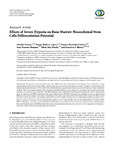Mostrar o rexistro simple do ítem
Effects of severe hypoxia on bone marrow mesenchymal stem cells differentiation potential
| dc.contributor.author | Cicione, Claudia | |
| dc.contributor.author | Muiños-López, Emma | |
| dc.contributor.author | Hermida Gómez, Tamara | |
| dc.contributor.author | Fuentes Boquete, Isaac Manuel | |
| dc.contributor.author | Díaz-Prado, Silvia | |
| dc.contributor.author | Blanco García, Francisco J | |
| dc.date.accessioned | 2015-06-11T11:27:18Z | |
| dc.date.available | 2015-06-11T11:27:18Z | |
| dc.date.issued | 2013-06-30 | |
| dc.identifier.citation | Cicione C, Muiños-López E, Hermida-Gómez T, Fuentes-Boquete I, Díaz-Prado S, Blanco FJ. Effects of severe hypoxia on bone marrow mesenchymal stem cells differentiation potential. Stem Cells Int. 2013;2013:232896. | es_ES |
| dc.identifier.uri | http://hdl.handle.net/2183/14663 | |
| dc.description.abstract | [Abstract] Background. The interests in mesenchymal stem cells (MSCs) and their application in cell therapy have resulted in a better understanding of the basic biology of these cells. Recently hypoxia has been indicated as crucial for complete chondrogenesis. We aimed at analyzing bone marrow MSCs (BM-MSCs) differentiation capacity under normoxic and severe hypoxic culture conditions. Methods. MSCs were characterized by flow cytometry and differentiated towards adipocytes, osteoblasts, and chondrocytes under normoxic or severe hypoxic conditions. The differentiations were confirmed comparing each treated point with a control point made of cells grown in DMEM and fetal bovine serum (FBS). Results. BM-MSCs from the donors displayed only few phenotypical differences in surface antigens expressions. Analyzing marker genes expression levels of the treated cells compared to their control point for each lineage showed a good differentiation in normoxic conditions and the absence of this differentiation capacity in severe hypoxic cultures. Conclusions. In our experimental conditions, severe hypoxia affects the in vitro differentiation potential of BM-MSCs. Adipogenic, osteogenic, and chondrogenic differentiations are absent in severe hypoxic conditions. Our work underlines that severe hypoxia slows cell differentiation by means of molecular mechanisms since a decrease in the expression of adipocyte-, osteoblast-, and chondrocyte-specific genes was observed. | es_ES |
| dc.description.sponsorship | This study was supported by Grants from Servizo Galego de Saúde, Xunta de Galicia (PS07/84), Cátedra Bioiberica de la Universidade da Coruña and Instituto de Salud Carlos III CIBER BBN CB06-01-0040, Ministerio Ciencia e Innovacion PLE2009-0144 and Fondo Investigacion Sanitaria-PI 08/2028 with participation of funds from FEDER (European Community); Tamara Hermida-Gómez is the beneficiary of a Contract from Fondo de Investigación Sanitaria (2008), Spain. Emma Muiños-López is supported by the Rheumatology Spanish Foundation, Spain. The authors would like to thank P. Filgueira and M. J. Sánchez for technical assistance. | es_ES |
| dc.description.sponsorship | Xunta de Galicia; PS07/84 | |
| dc.description.sponsorship | Instituto de Salud Carlos III; CB06-01-0040 | |
| dc.description.sponsorship | info:eu-repo/grantAgreement/MICINN/Programa Nacional de Internacionalización de la I+D/PLE2009-0144/ES/In situ Tissue Engineering using Stem Cells and Functional Biomaterials to Repair Articular Cartilage: An ''in Vivo Model" | |
| dc.description.sponsorship | Instituto de Salud Carlos III; PI 08/2028 | |
| dc.language.iso | eng | es_ES |
| dc.publisher | Hindawi | es_ES |
| dc.relation.uri | http://dx.doi.org/10.1155/2013/232896 | es_ES |
| dc.rights | Creative Commons Attribution 4.0 International Licence (CC-BY 4.0) | |
| dc.rights.uri | http://creativecommons.org/licenses/by/4.0/ | |
| dc.title | Effects of severe hypoxia on bone marrow mesenchymal stem cells differentiation potential | es_ES |
| dc.type | info:eu-repo/semantics/article | es_ES |
| dc.rights.access | info:eu-repo/semantics/openAccess | es_ES |
Ficheiros no ítem
Este ítem aparece na(s) seguinte(s) colección(s)
-
GI-TCMR - Artigos [130]
-
INIBIC-TCMR - Artigos [102]
-
INIBIC- REUMA - Artigos [184]






